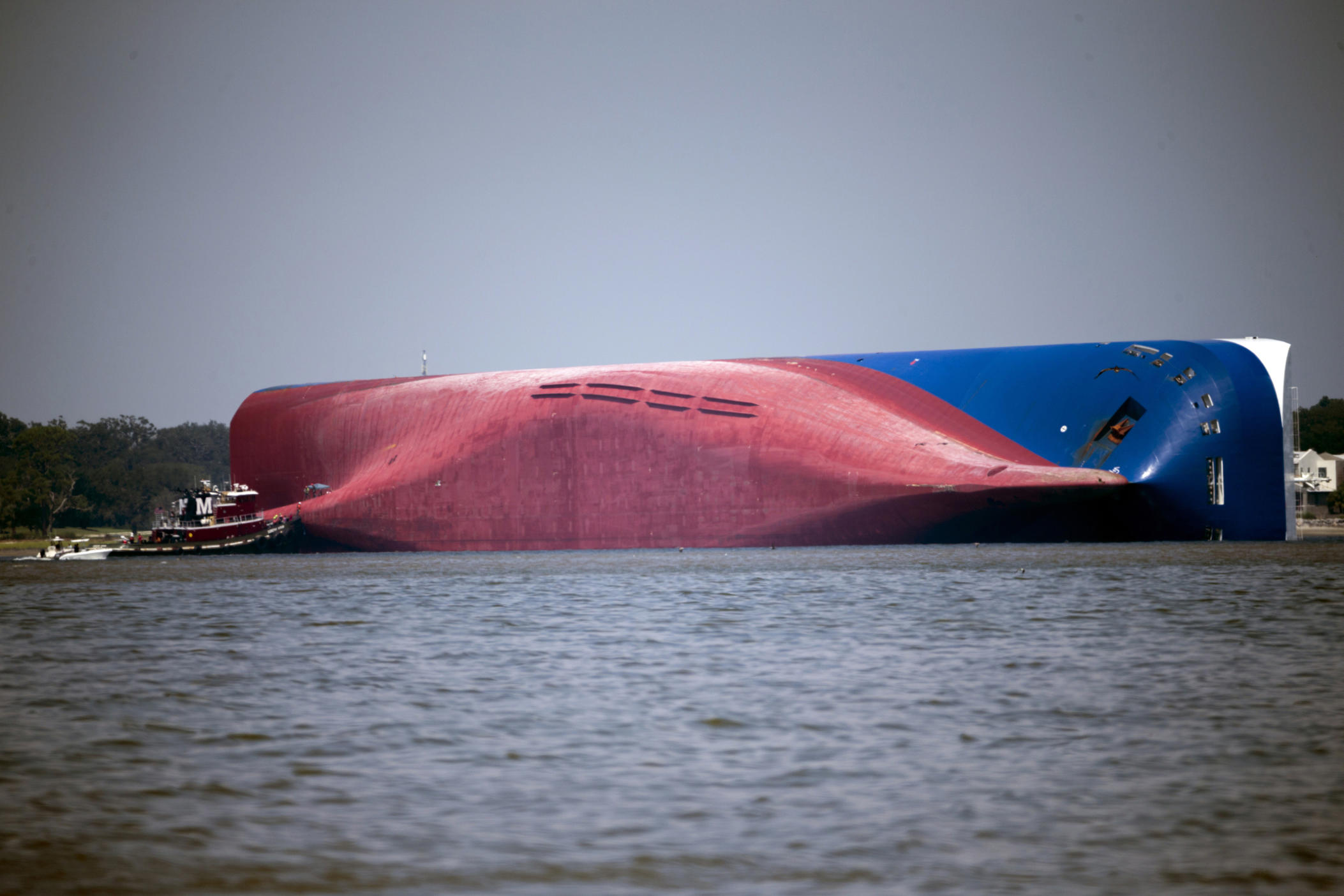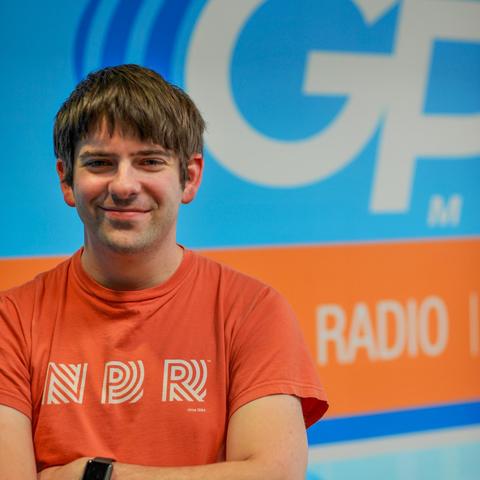Section Branding
Header Content
Georgia Today: Capsizing, Crew Rescue and Cutting Up Of The Golden Ray Cargo Ship
Primary Content
It’s been over a year since the Golden Ray capsized off the coast of St. Simons Island. Crews recently resumed work to dismantle the giant vessel. On Georgia Today this week, Brunswick News reporter Larry Hobbs discusses how the Golden Ray came to capsize in the first place, the tense hours as rescuers tried to free trapped crew members, and what emerged from hearings into the possible causes of the disaster.
RELATED: 'Chain advancing its way through Golden Ray'
TRANSCRIPT:
Steve Fennessy: This is Georgia Today, a production of Georgia Public Broadcasting. I'm Steve Fennessy. It's Friday, Oct. 27, 2020.
Coast Guard Operator: Coast Guard report, the cargo ship Golden Ray capsized with 23 persons onboard in the vicinity of St. Simon’s Sound.
Steve Fennessy: For more than a year, a massive cargo ship — longer than two football fields — has lain on its side just off the coast of St. Simon's Island in southeast Georgia. Crews recently resumed work to dismantle the giant vessel. Larry Hobbs has been following that herculean task. He’s a reporter at the Brunswick News. I talked with Larry about how the Golden Ray capsized in the first place. We also looked back at the tense hours last year when rescuers worked to free trapped crew members, and what hearings this fall revealed about what may have caused the disaster. Larry, for those of us who have not been to the Georgia coast in a while, what's different about the view of St. Simons Sound these days?
Larry Hobbs: What's different is there is a 656-foot long, roughly 75,000-ton RORO ship.
Steve Fennessy: What's a RORO ship?
Larry Hobbs: A car carrier roll — cars roll on one place and they roll off at the next port. This one is called the Golden Ray and it's dumped over, roughly half submerged in high tide.
Locals probably don't remember what the view looked like without it, because it is imposing, it's like some kind of megalith or something that just juts out of the water.
Steve Fennessy: It's now part of the landscape — the seascape.
Larry Hobbs: Yes, exactly.
Steve Fennessy: Let's talk a little bit about how it came to be there. Take us back to Sept. 7th. I know that the — the ship capsized there in the sound in the early morning hours of Sept. 8th. But the ship first arrived — everything was sort of business as usual, right, on Sept. 7th?
Larry Hobbs: Yes, it was. It's — it's probably important to go back to the whole thing. It began and made two stops in Mexico, one in Freeport, Texas. That's where its new captain, Gi Hak Lee, got on. Then it came to the port in Jacksonville, intentionally following behind Hurricane Dorian. Then it came to Brunswick.
Steve Fennessy: So it was — it was a few days behind schedule because of the hurricane it was trying to tail?
Larry Hobbs: Right. And it unloaded something in the neighborhood of 280 cars and took on something in the neighborhood of 360 cars.
Steve Fennessy: This is in Brunswick.
Larry Hobbs: In Brunswick. Yes.
Steve Fennessy: OK.
Larry Hobbs: Brunswick is one of the leaders in the RORO industry. One of the leading ports in America.
Steve Fennessy: OK. And that — there was nothing unusual about that process that seemed to work — go according to expectations?
Larry Hobbs: Everyone from the stevedore foreman to the ship's owner to the captain of the ship, to Captain Tennant, the harbor pilot, said everything was in fine working order and was ready to depart shortly after midnight on Sept. 8.
Steve Fennessy: Larry, you mentioned Captain Jonathan Tennant, who wasn't a captain of the Golden Ray, but actually a Brunswick harbor pilot. So for those of us who don't know how it works when you're piloting these enormous ships in and out of a port, what is the job of a harbor pilot?
Larry Hobbs: The harbor pilot knows his or her port like no one else. Their job is to know every nuance of the port of Brunswick. And this tradition goes back, literally — it's as old as going to sea. A person comes out, meets the ship at sea before it comes in right where the channel begins, and they board the ship, they talk to the captain, the captain hands over, then the harbor pilot does just that. He pilots the ship into the harbor.
Steve Fennessy: So piloting one of these — these ships out of the harbor and towards the sea requires a kind of a right turn, a starboard turn that's relatively sharp but is completely normal. And that's what Captain Tennant has done thousands of times.
Larry Hobbs: Yes.
Steve Fennessy: So what happens when he does it this time?
Larry Hobbs: He goes into — from a 10-degree turn, into the standard 20-degree turn, and that's when he feels it's listing to starboard significantly.
Steve Fennessy: So it's tipping.
Larry Hobbs: Right. He's piloted this journey thousands of times. But he testified nothing in his years of experience prepared him for what happened on that dark Monday night in Sept. 8th.
Jonathan Tennant: The vessel immediately took off to starboard. More so than I've ever experienced before in my career. So this is — this explanation is very long. But realize that this took place in a few seconds.
Steve Fennessy: So Captain Tennant is basically turning the wheel to starboard, to the right side and in a ship starts to list to that side. So does he — does he steered the opposite way to sort of correct for that — that list?
Larry Hobbs: So at one point, he talks about going all the way to port. But at that point, it was — he says all was lost.
Jonathan Tennant: I am still level. I'm still — I have no idea that I'm about to capsize at this point.
Larry Hobbs: Suddenly, the port-side wall of the bridge becomes the floor and it is just chaos in there.
Captain Tennant, the harbor pilot, he was trying to get it out of the channel and up onto the sand on the other side of it so that the ship wouldn't go completely underwater. And he was talking about, say, he's like, "This is no longer a piloting operation, this is a lifesaving operation."
Steve Fennessy: So I'm just trying to imagine what it feels like to be on a ship that's that huge carrying that much cargo, and it starts to list and starts to capsize. And I'm trying to imagine how terrifying that must be for the people onboard.
Larry Hobbs: Yeah. The people were terrified. Especially the four who were down by the engine room. They get stuck there. Back to the bridge, they are literally laying sideways and holding on to anything they can to keep from falling out of this thing, which jumped over on the sandbar there.
Steve Fennessy: And then, of course, there is the 4,200 cars on there. And I can imagine what a mess that looks like onboard.
Larry Hobbs: Right it — it's — they have straps to keep them in place. Just, you know, those straps are not made to hold anything in place sideways. And most of those give and hear cars crashing.
Steve Fennessy: Wow.
Larry Hobbs: Falling inside there. Apparently, Captain Tennant gets out some information on the ship's radio before all power is lost, and he calls Coast Guard. It goes to Coast Guard station Charleston.
Coast Guard Captain John Reed: Coast Guard report, the cargo ship Golden Ray capsized with 23 persons onboard in the vicinity of St. Simon’s Sound.
Larry Hobbs: A Coast Guard helicopter arrives and, you know, one of these guys, he's trained to do this all their life, does it. He rappels down there into the ship's bridge, assesses the situation, and he makes assessment of it, switches to a Plan B, which is to take a firehose and roll it down all the way through the starboard side out the port-side door.
Coast Guard Radio feed: ….OK, I'm going to bring you back up.
Larry Hobbs: Captain Tennant climbs down that and into the water where he's picked up. The ship's captain, Gi Hak Lee, does not want to leave. He says, "I've got four people down in the engine room and I do not want to leave without them." Finally, Coast Guard convinces him to leave by telling him "You're the only one that can help us when we start going after them; we're going to need you to tell us where to go."
Steve Fennessy: So is this — is it still pre-dawn hours at this point or has the sun come up?
Larry Hobbs: Most of this takes place in the dark.
Steve Fennessy: OK. And meanwhile, there's four — you said there's four crew members who are down in the engine room, which I'm presuming is towards the bottom of the ship, right?
Larry Hobbs: The very bowels of the ship.
Steve Fennessy: They're trapped, right? How are they trapped?
Larry Hobbs: They are trapped and there is an escape hatch. And water is coming through the escape hatch.
Steve Fennessy: So is the compartment filling with water?
Larry Hobbs: Yes.
Steve Fennessy: Does that stop at some point?
Larry Hobbs: It does.
Steve Fennessy: Because presumably if it kept going, they, they would have drowned.
Larry Hobbs: The reason it doesn't is because it's not in the deeper channel.
Steve Fennessy: OK. And so — so because it was grounded as opposed to being in the middle of the channel, it came to rest before it could submerge to a point where it would have drowned those four crew members.
Larry Hobbs: Yes, sir.
Steve Fennessy: Wow.
So what is — what's sort of the protocol or what's the procedure for trying to first identify where they are and then rescue them?
Larry Hobbs: It's old-fashioned; It's like the — that movie The Poseidon Adventure. They bang on — this is the next afternoon, Sept. 8th. Coast Guard members, other members of the rescue team — someone is banging with a hammer and they get a, you know, a return bang. That's bang, bang, bang. One person is alive, they're saying we can — we can — we know one person is alive because we’re getting that banging, we know we can save one person.
Steve Fennessy: OK.
It's — this is, what, September — Sept. 8th last year? That's still that's still the peak of summer and in southeast Georgia. So —
Larry Hobbs: Oh yes.
Steve Fennessy: So is there any estimates about how hot it was getting inside that engine room?
Larry Hobbs: It was broiling hot. I mean, the sun comes out, they're in there the whole day. They literally take, I guess, they take a welding torch and weld out a little hole in the hull. Hull’s about two inches thick, I think they said. When that drops out, they can feed water in there, they found out all four are alive.
Steve Fennessy: OK.
Larry Hobbs: One behind a glass partition in the engineering room. But all four are alive. They use that to pump in fresh air, which was much needed at that point. Once they — once they have established this and they've gotten some water to them, they've gotten fresh air, they also find out the one way they’re keeping cool is — there’s oil everywhere inside now. They're staying cool by literally going into pools of oil that are inside the engine room, now. That is concerning to rescuers because, you know, a single spark could take this a different way. So carefully, they decide to make a series of small holes like the one that they first made and make these in a circle until each hole meets and a piece drops out that’s large enough to pluck four men out of there.
Steve Fennessy: OK, so they’re — I want to make sure I understand this — so they're using an arc welder, something that's throwing sparks and so could potentially ignite some of the oil that's spilled inside that engine room. That must have been pretty nerve-wracking.
Larry Hobbs: I can't imagine it was anything but. That’s essentially how they ended up getting these — these four gentlemen out more than 36 hours later.
Steve Fennessy: Wow.
Larry Hobbs: The last man out was the man behind the partition. He came out about an hour after his three crewmates that were down there.
Newscast: The four crew members trapped inside a capsized cargo ship are safe thanks to heroic rescue efforts by the U.S. Coast Guard. This means all 24 people who were aboard the huge vessel when it capsized are now off that ship and alive.
Steve Fennessy: I think I read in one of your stories that, like, the most serious of the injuries was a few broken fingers, maybe.
Larry Hobbs: Few broken fingers. I think one person was reported with — it was a broken ankle. I think it was later, like a fracture.
Steve Fennessy: The environmental impact of the shipwreck, and the long road ahead to remove the Golden Ray from the water’s of St. Simon’s Sound. That’s ahead. This is Georgia Today.
[BREAK]
Steve Fennessy: This is Georgia Today. We're talking to Larry Hobbs, a reporter for the Brunswick News about the Golden Ray shipwreck one year later.
Newscast: Finding out what caused a cargo ship to overturn in St. Simon's Sound. Today, the Coast Guard and National Transportation Safety Board began a weeklong public hearing to find out.
Steve Fennessy: Back in September, there was over a week of hearings to sort of figure out how did all of this happen, right?
Larry Hobbs: Their purpose was to find out why this happened and to take steps so that it does not happen again. They have stated throughout that they are not looking to place blame or impose penalties or anything like that. They want to find out why this happened and how it can be prevented in the future.
Steve Fennessy: And over the course of these hearings, did an answer emerge as to why this happened?
Larry Hobbs: An engineering expert from the Coast Guard, Ian Oviatt, basically assumed that it was top-heavy and riding too high. It took on fifteen hundred tons of ballast in the Gulf of Mexico in the form of saltwater.
Ian Oviatt: Had the vessel kept the additional ballast onboard that was discharged during the Freeport to Jacksonville voyage, this would likely have prevented the capsize.
Steve Fennessy: Ballast is basically, if I'm understanding this correct, added weight that gives a ship sort of its center that keeps it stable in the water and the ballast can be — they can be taking on water, in other words, to provide ballast, is that right?
Larry Hobbs: Right. The ship was coming in — as we talked about Hurricane Dorian or any extreme weather they might encounter — they took on ballast. Somewhere after the time that the threat of Dorian was over, they released all of that ballast.
Steve Fennessy: And just to be clear, that — that's the testimony from one expert, but isn't the final sort of determination by the Coast Guard or the NTSB about the cause. Is that right?
Larry Hobbs: They have not made a final ruling on what they thought caused it.
Steve Fennessy: So when are we expecting a determination or a ruling from the NTSB and Coast Guard about what caused this?
Larry Hobbs: Within the next few months,
Steve Fennessy: OK.
Larry Hobbs: These take time.
Steve Fennessy: Right.
So what happens to the Golden Ray now? What — what have officials determined that they're going to do with it?
Larry Hobbs: Well, Unified Command — which is the Coast Guard, the State Department of Natural Resources, and Gallagher Marine Systems — makes sure that the salvage follows all environmental protocols set forth by the Oil Pollution Act of 1990. In other words, they're — they're there to make sure the owner of the ship complies with everything, does not leave a mess, does not destroy the environment, and pays for all damage.
Steve Fennessy: And Gallagher Marine Systems is a regulatory compliant support agency that is hired as part of the salvaging group. So, OK. The owner of the ship, which is Hyundai Glovis, they're financially responsible for the cleanup, right?
Larry Hobbs: Right.
Steve Fennessy: So what are some of the steps that are being taken? Do they somehow remove the cars from the ship or are they still on there?
Larry Hobbs: Oh, they're still there. They're not going anywhere. There were some things that they considered that they could do that just — it was later determined were not going to work for this.
Steve Fennessy: OK.
Larry Hobbs: One of it was like trying to, you know, hook up some chain to a tug and pull it off of there. But it, just, it was so inundated, all of its cargo was downhill. You know, most of it was on the port side weighing it down there. It was — it was not coming out.
Steve Fennessy: I see. It was stuck and there was no — there's no un-stucking it.
Larry Hobbs: No.
Steve Fennessy: OK, so the ship's owner has come up with a plan to cut the ship up into pieces.
Larry Hobbs: Eight pieces.
Steve Fennessy: Eight pieces. And the Unified Command has approved that plan?
Larry Hobbs: They have.
Steve Fennessy: And the work to cut up the vessel continues Now, Larry I understand to cut it up, responders will have to use this enormous piece of lifting machinery that’s got this great name — the VB-10,000. What is the VB-10,000 and how does it work?
Larry Hobbs: The VB-10,000 looks like something out of War of the Worlds. It is 155 feet high. That's higher than the roadway on the Sydney Lanier Bridge. It's for lifting and it's going to be for cutting, now. It's made to dismantle old oil wells in the Gulf.
Steve Fennessy: Oh, OK. So it's — is it sort of like a partly — like a water-borne crane?
Larry Hobbs: It is; that is exactly what it is.
Steve Fennessy: OK.
Larry Hobbs: They're going to cut this with anchor chains attached to powerful winches. As Coast Guard Commander Norman Witt has told me, it's more like tearing; they're going to tear these pieces through the ship. This is sheer force.
Steve Fennessy: So the cutting of it is not done by, like, a massive welder. It's done by the chains themselves?
Larry Hobbs: Yes, they're going to be attached to this VB-10,000.
Steve Fennessy: Here we are over a year since the incident. Why is it taken so long to begin to cut the thing up and get rid of it? Why — why is it still there?
Larry Hobbs: Nobody's ever done this to this degree. They did a similar thing with a RORO ship off of the English Channel, but it was pretty much out in the open waters. This is, I mean, this thing is plopped down between two resort islands in a very fragile and important ecosystem.
Steve Fennessy: Well, let's talk about that ecosystem, because I recall that in the days and weeks after the Golden Ray capsize, that there were a lot of environmentalists really concerned about fuel — oil spill, basically — coming from the ship. So how much environmental damage was done as a result of this?
Larry Hobbs: It looked pretty bad. Starting, I think, Sept. 10, Sept. 11, there were two oil spills, like you could see the — a black line, looked almost like a magic marker had drawn it, at the high tide mark when the tides receded, that was — that was oil. Fishing guides were complaining and showing that it was on the hulls of their boats when they went out. It was just a mess. But Coast Guard, DNR, they had — they put booms out which absorb the oil that is meant to catch oil that comes to the surface.
Steve Fennessy: Have they drained the ship of the fuel that remained in there that wasn't spilled out?
Larry Hobbs: Some of the tanks, they simply could not reach.
Steve Fennessy: OK.
Larry Hobbs: But they — several months it took, and began almost immediately after the Golden Ray capsized. They began pumping the oil out of there.
Steve Fennessy: So it's not like that ship has just been sitting there for a year and no one's done anything. They've been — they've been working on it. They've been trying to relieve it of the fuel. So when they do cut it up, it's not going to be spilling all over St. Simon's Sound.
Larry Hobbs: Yes. We haven't even talked about the environmental protection barrier, which took them four months to build.
Steve Fennessy: What's that?
Larry Hobbs: This is a massive piece of engineering. It is 80 poles set in pairs all the way around the shipwreck to support a netting made of very sturdy material that's essentially meant to catch, I don't know, a Kia Telluride that might be rolling in the tide. Anything that shakes when they start this cutting process.
Steve Fennessy: Wow.
Larry Hobbs: It’s going to be loud.
Steve Fennessy: What's been sort of the response of locals to this accident?
Larry Hobbs: It's actually, you know what? It's become a — it's just become a part of the — part of the area. People are really excited, waiting for when they're going to get down to this work. You know, we know each other is a small town, small community, I work for a small paper. I know a lot of these people. Everybody has questions that they want answered. But mostly I think people wanna see the Golden Ray outta here. That's not a fixture we want to see laying around here anymore.
Steve Fennessy: Our thanks to Larry Hobbs, a reporter for the Brunswick News. Last week, St. Simons Unified Command announced that work to cut up the Golden Ray had resumed. It was put on hold because of Tropical Storm Eta. John Maddox is the On-scene Coordinator with the Georgia Department of Natural Resources. In a statement, he says additional equipment has been installed to reduce environmental threats as the vessel continues to be broken up. I'm Steve Fennessy. This is Georgia Today, a production of Georgia Public Broadcasting. You can subscribe to our show at GPB.org/GeorgiaToday, or anywhere you get podcasts. Please leave us a rating and review on Apple podcast. Our producers are Sean Powers and Pria Mahadevan. Our intern is Eva Rothenberg. Thanks for listening. We'll see you next week.




